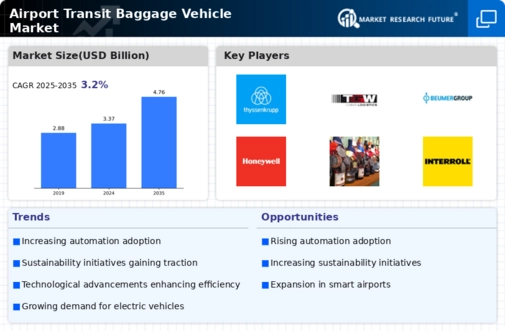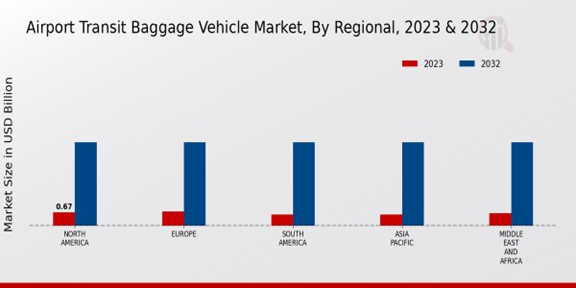Regulatory Compliance
Regulatory frameworks are shaping the Global Airport Transit Baggage Vehicle Market Industry by mandating higher safety and operational standards. Governments and aviation authorities are implementing stringent regulations regarding baggage handling processes, which necessitate the adoption of advanced baggage vehicles. Compliance with these regulations often requires airports to upgrade their existing fleets, driving demand for modern vehicles that meet safety and efficiency standards. As regulatory pressures increase, airports are likely to invest in new technologies and vehicles, further propelling market growth. This trend underscores the importance of adhering to safety protocols in enhancing operational reliability.
Rising Air Travel Demand
The Global Airport Transit Baggage Vehicle Market Industry is experiencing growth driven by the increasing demand for air travel. As global passenger numbers rise, airports are compelled to enhance their operational efficiency, leading to a greater need for effective baggage handling solutions. In 2024, the market is valued at approximately 3.37 USD Billion, reflecting the industry's response to this surge in air traffic. Airports are investing in advanced baggage vehicles to streamline operations, reduce turnaround times, and improve passenger satisfaction. This trend is expected to continue, as the International Air Transport Association projects that global passenger numbers will reach 8.2 billion by 2037.
Market Growth Projections
The Global Airport Transit Baggage Vehicle Market Industry is projected to experience substantial growth, with an estimated value of 4.76 USD Billion by 2035. This growth trajectory reflects the increasing investments in airport infrastructure and the rising demand for efficient baggage handling solutions. The market is expected to achieve a CAGR of 3.18% from 2025 to 2035, indicating a steady expansion driven by technological advancements and regulatory compliance. As airports worldwide seek to enhance operational efficiency and passenger experience, the demand for innovative baggage vehicles is likely to rise, further contributing to the market's robust growth.
Sustainability Initiatives
Sustainability has emerged as a crucial driver in the Global Airport Transit Baggage Vehicle Market Industry. Airports are increasingly focusing on reducing their carbon footprint, leading to a demand for eco-friendly baggage vehicles. Electric and hybrid models are gaining traction as they align with global sustainability goals. For example, several airports are transitioning to electric baggage tractors, which not only reduce emissions but also lower operational costs. This shift is indicative of a broader trend towards sustainable practices in the aviation sector, which is expected to influence market dynamics significantly as stakeholders prioritize environmentally responsible solutions.
Technological Advancements
Technological innovations play a pivotal role in shaping the Global Airport Transit Baggage Vehicle Market Industry. The integration of automation, IoT, and AI in baggage handling systems enhances operational efficiency and reduces human error. For instance, smart baggage vehicles equipped with sensors can monitor baggage conditions in real-time, ensuring timely handling and minimizing loss or damage. As airports increasingly adopt these technologies, the demand for modern baggage vehicles is likely to rise. This trend aligns with the projected market growth, with an expected CAGR of 3.18% from 2025 to 2035, indicating a robust future for technologically advanced baggage handling solutions.
Expansion of Airport Infrastructure
The expansion of airport infrastructure is a significant driver of the Global Airport Transit Baggage Vehicle Market Industry. As new airports are constructed and existing ones are upgraded, the demand for efficient baggage handling systems intensifies. This expansion is particularly evident in emerging markets, where governments are investing heavily in airport development to accommodate growing air traffic. The anticipated growth of the market to 4.76 USD Billion by 2035 highlights the correlation between infrastructure development and the need for advanced baggage vehicles. Enhanced airport facilities necessitate the integration of modern baggage handling solutions to ensure seamless operations.

























Leave a Comment